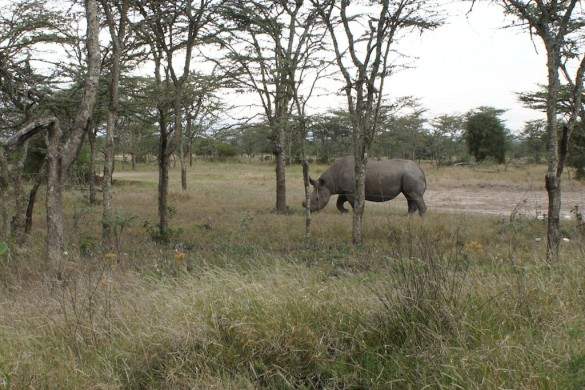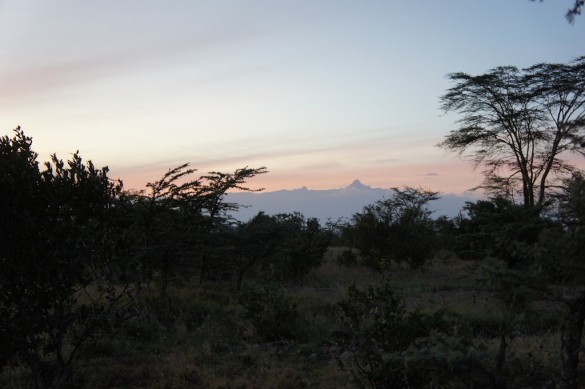When our Earthwatch group spotted its first Black Rhino out on an afternoon game walk in Kenya, the distance was not so great. I felt my pulse quicken, and something inside declared, ‘Yes, you are here!”
I’ve dreamed of the African bush for so many years. However, this was not my maiden visit. On that first trip, in South Africa, I realized that there is a learning curve to touring in Africa. The things I did get right included staying at backpackers’ lodges and walking the cities with new friends. After a jeep safari, I had seen amazing landscapes and wildlife. Still, I knew that the whole thing was just a little too protected. I wanted an on-the-ground experience that would give me the sensation of really being there — connecting with the land, the people, and of course, the animals.
Planning for this second trip, I considered just winging it upon arrival, or maybe doing an adventure tour. I wanted a connection to the place that comes from participating in something. I recalled a volunteer book, that had been languishing under my bed for about 15 years, and which espoused the virtues of an Earthwatch vacation. Earthwatch is an organization that works world-wide to get people involved in scientific research, and to promote environmental sustainability. The nice thing about the passage of the 15 years was that I could better afford the cost of volunteering for such an expedition. At nearly $3,000 it is steep, but also it is comparable to many of the adventure tours of equal duration.
On the Earthwatch website I found a variety of interesting expeditions all over the world. “Saving Kenya’s Black Rhinos” caught my attention immediately.

I recalled having read about the plight of the rhinoceros in Africa and the battle to protect them from poachers. The overview from Earthwatch filled in the gaps.
The number of black rhinoceroses in Kenya has fallen from an estimated
figure of 20,000 in 1970 to about 539 today. There are about 150 black rhinos in zoos, mainly in North America and Europe. The total world population is currently approximately 2,500; in 1970, the total world population was approximately 65,000 individuals. In Kenya, the surviving rhinos are concentrated in a number of sanctuaries in
which they are protected from poaching—the major threat to their continuing existence. However, this inevitably means that individual populations are small, usually less than 100, and confined to relatively small geographical areas. Nevertheless, rhino populations in these sanctuaries are increasing. In the future, these breeding populations may be used to reintroduce rhinos to their former areas, hence their critical importance.
In the end, I decided that I wanted an experience that combined adventure and conservation. Earthwatch fit that bill.
A couple of short months later, I joined a group of volunteers at the Fairview Hotel in Nairobi. We were met by an Earthwatch driver and transported to the Ol Pejeta Conservancy near Nanyuki in a small matatu, or mini-van, with our luggage strapped on top. The four-hour drive left me fatigued, and possibly flirting with a diesel overdose, but the moment we drove into the conservancy the herds of zebras, hartebeest, and gazelles lifted my mood. This definitely wasn’t the end of my usual commute.
Upon arrival, we chose our sleeping quarters. The choices were either a small room in a rondavel, which is a round hut with a thatched roof; or a sturdy tent. Bathrooms, showers, and dining facilities were in the main research building. We were further instructed to be careful wandering around at night because you might walk into an elephant or something. I began my stay in a tent, and congratulated myself as I could hear the zebras and lions roaring so clearly at night. However, mid-way through our tour — after the mongoose discovered how much fun it was to play on top of my tent — I happily changed to a quieter quarters in a rondavel.
The next day our training began in earnest with lectures, slide presentations, and field practice. Sadly, we learned that the fight against poachers was being waged inside the conservancy. We observed that the Kenyan Wildlife Service was a regular presence at the conservancy and some individuals were arrested during our time there. The largest part of what we would do to protect the Black Rhino involved collecting data on other competing herbivores in the habitat, and monitoring the health and growth of the conservancy’s Acacia Drepanolobium; a thorny tree which is the rhino’s primary food source.
 Once the fieldwork was underway, the days typically began with breakfast at 7 a.m. We were transported to the worksite by 7:30 or 8:00 a.m. and worked together in teams of two-three people. The time we spent traveling to and from these worksites often were like mini-game drives where we might see zebras and warthogs, or even cheetahs and lions. The lions really are the King of the Beasts here. They would sometimes stroll up to the jeep to have a closer look at you, or nonchalantly walk down the middle of the road in front of the jeep as if they didn’t know we were behind them.
Once the fieldwork was underway, the days typically began with breakfast at 7 a.m. We were transported to the worksite by 7:30 or 8:00 a.m. and worked together in teams of two-three people. The time we spent traveling to and from these worksites often were like mini-game drives where we might see zebras and warthogs, or even cheetahs and lions. The lions really are the King of the Beasts here. They would sometimes stroll up to the jeep to have a closer look at you, or nonchalantly walk down the middle of the road in front of the jeep as if they didn’t know we were behind them.
The actual work in the field often involved surveying previously tagged trees and measuring them for such things as growth, damage and ant infestation. This may not sound like exciting work, but doing it in these surroundings made it interesting. Generally, the daily field tasks, including transport, would take 3-4 hours. Then in the afternoons we would work with our teammates to input our data into the research database.
There were days when we didn’t have to measure trees. Other field projects included walking a six to eight-kilometer transect to survey animals in the habitat and find indications of the presence of elephants. That’s a nice way of saying that we counted elephant piles, but given enough fresh piles of dung, we found that often there were indeed elephants close at hand. Sometimes we would come upon some dense wooded areas where a field of gray loomed behind a nearby tree. On several occasions the patch of gray turned out to be not a rock or boulder, but a rhinoceros or an elephant.
During our time there, my teammate and I had two close encounters with the rhinos that we were working to protect. On the first occasion our guard halted us suddenly and bade us a quick and silent retreat. I had come to trust our experienced security guards, so without qualms I retreated quietly as instructed. Only later did I realize how close we were to a territorial male. On another occasion, we stumbled upon a mother rhino browsing with her baby. Not well known for their eyesight, she ran toward us rather than away. While we jumped behind the nearest bush, James, our guard that day, fired a warning shot that sent the pair safely in the other direction.
In addition to the fieldwork, our schedule built in time for other activities. Some of these were organized and included: game walks and drives, campfires, lectures, and presentations on the myriad conservation efforts taking place in the conservancy. Additionally, there was a rest day on which we traveled to the Nakuru National Park. Nakuru gave us a view of a different habitat that included a large lake populated by flocks of white pelicans, flamingos, and the herd animals that we’d become accustomed to seeing at the conservancy.
One of the things that I most enjoyed was just hanging around our research center in the evenings and sharing stories with the Ol Pejeta researchers and staff . What I think of as the “real” researchers at the camp included the leader of our project, Dr. Geoffrey Wahungu, resident researchers that would stay for extended periods of time, as well as graduate students. All of these people brought a wealth of experience. They came to study a variety of research questions connected to the animals and habitats at the conservancy. Sometimes we just hung around the campfire enjoying some wine or Tuskers, the local beer, and greedily taking in the stories of those who made the conservancy their home for a time.
On “Community Day” we toured the surrounding areas rather than working in the field, and became acquainted with the community-building arm of the conservancy. The efforts here included shared land use with local cattle herders, improvement of area schools, and the development of medical dispensaries on the conservancy boundaries. Most of us gained a stark realization on this day of the needs of these communities, and many of us started thinking about how we might contribute when we returned home.

The duration of the Earthwatch program at Ol Pejeta was 15 days. Fifteen days is not long when you’re traveling to the other side of the world. However, each day brought with it amazing sights and experiences that will stay with me into old age. I can still hear the whisper of a fellow volunteer on that first day softly saying, “Rhino,” and looking up to see, not 100 meters away, a black rhinoceros quietly browsing on the Acacia trees that we had been surveying.
Given the increased pressure of poaching in Kenya and in other parts of the world, it felt right to progress beyond the jeep-safari, and to try to help local people in their efforts to protect their wildlife. The adventure did not disappoint.